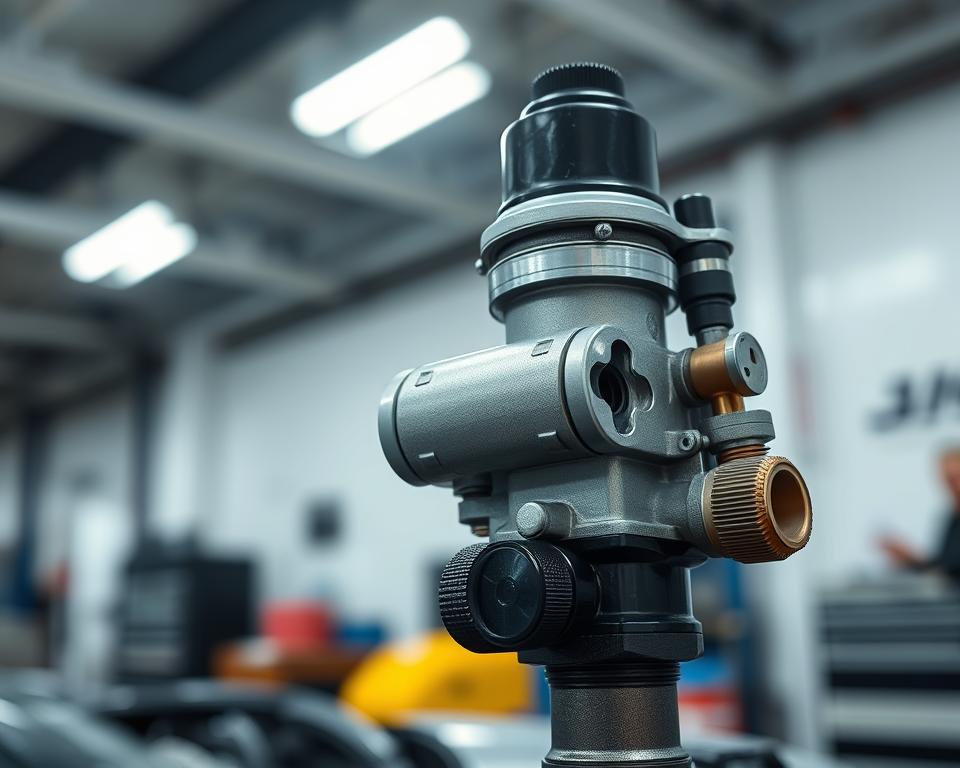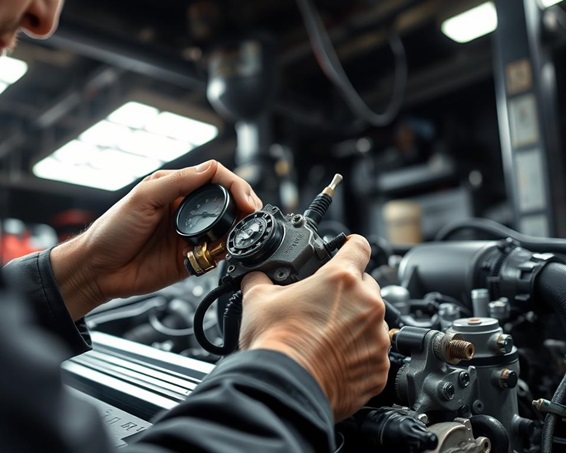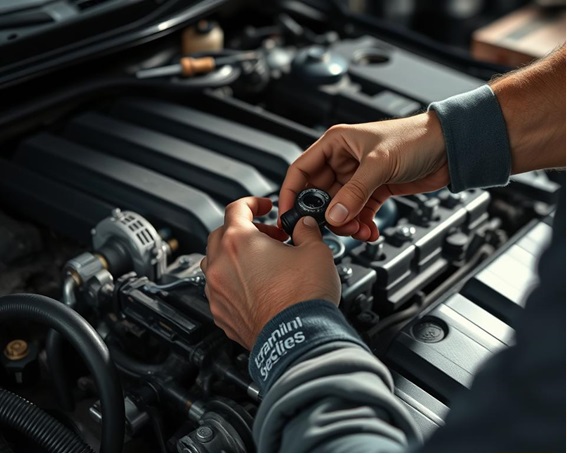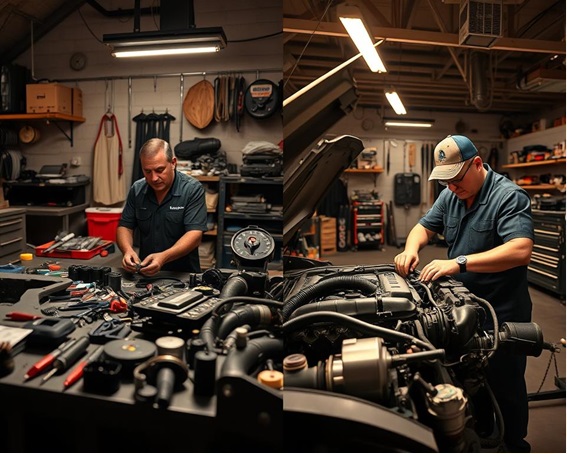
The Idle Air Control Valve (IAC) is key for your car’s engine to run well. It keeps the engine’s idle speed right, stopping it from stalling or idling roughly. Knowing how it works, when it fails, and how to replace it is vital for your car’s health.
A bad IAC can cause problems like worse fuel use and stalling. Replacing it is easy, but the price changes based on your car’s type. This article will cover IAC replacement, its importance, signs of trouble, and the cost.
Key Takeaways
- Understanding the role of the Idle Air Control Valve in engine operation.
- Recognizing the signs of a faulty IAC.
- The process and cost associated with IAC replacement.
- Factors influencing the cost of replacement.
- Importance of timely replacement for maintaining vehicle performance.
What Is an Idle Air Control Valve and How Does It Work?
The idle air control valve is key in modern cars. It makes sure the engine runs smoothly. It controls the air that goes into the engine when it’s idling.
The Function of an Idle Air Control Valve in Your Engine
The IAC valve keeps the engine running smoothly when it’s not working hard. It changes the air flow to the engine. This helps with things like engine load, temperature, and electrical needs.
|
Component |
Function |
Impact on Engine |
|
IAC Valve |
Regulates Airflow |
Maintains Stable Idle Speed |
|
Engine Management System |
Monitors Engine Conditions |
Adjusts IAC Valve Accordling |
|
Throttle Body |
Controls Airflow During Acceleration |
Works in Conjunction with IAC Valve |
How the Idle Air Control Valve Regulates Engine Speed
The IAC valve controls engine speed by changing air flow. When the engine is idling, it keeps the air flow steady. This is important to avoid stalling, which is more likely when the engine is cold or under extra load.
Knowing how the Idle Air Control valve works helps us understand modern engines. It shows why regular maintenance is important. This keeps the engine running smoothly and prevents problems with idle speed control.
Common Signs Your Idle Air Control Valve Needs Replacement
When your Idle Air Control Valve fails, it can cause many problems. The IAC valve is key for keeping the engine’s idle speed smooth. Knowing the signs of a bad IAC valve is vital for fixing it fast and avoiding engine damage.
Irregular Idle Speed and Engine Stalling
Irregular idle speed is a common sign of a bad IAC valve. You might see the engine hunting or surging when idling. Or, it might stall a lot. Engine stalling is risky, so it’s a clear sign the IAC valve needs fixing.
For more on how the IAC valve works, check out The Drive’s guide on Idle Air Control.

Check Engine Light Illumination
The check engine light can also mean your IAC valve is bad. Modern cars have systems that spot problems with the IAC valve. This light can mean many things, but a bad IAC valve is a common cause.
It’s important to use the right tools to find out if the IAC valve is the problem.
Poor Acceleration and Engine Performance
A bad IAC valve can also make your car hard to accelerate. It can mess up the air-fuel mix, making your car slow to pick up speed. This is noticeable when you’re merging onto highways or going up steep hills.
Fixing the IAC valve quickly can help your car run better and avoid more damage.
Understanding Why Idle Air Control Valves Fail
It’s important to know why Idle Air Control valves fail. This helps us fix problems before they get worse. The IAC valve keeps the engine running smoothly at idle. If it fails, the engine might not run right.
Carbon Buildup and Contamination
Carbon buildup is a big reason for IAC valve failure. The valve gets clogged with carbon over time. This makes it hard for the valve to work right.
Poor fuel quality, bad combustion, or a dirty engine can cause this. It’s like when your coffee maker gets all clogged up.
Electrical Issues and Circuit Problems
Electrical problems also cause IAC valve failure. Issues with wiring or the valve’s circuit can stop it from working. This can make the engine act weird or not idle right.
Normal Wear and Tear Over Time
The IAC valve wears out like any engine part. As it gets older, it doesn’t work as well. Regular checks can catch problems early.
Diagnosing Idle Air Control Valve Problems
Learning to spot problems with your car’s Idle Air Control (IAC) valve can save you money. It takes both modern tools and old-school checks to figure out what’s wrong.
Using OBD-II Scanners for Diagnosis
An OBD-II scanner is a top tool for finding IAC valve issues. It shows how well your engine is running and points out IAC problems.
Common Error Codes Related to the Idle Air Control Valve
Know the error codes your OBD-II scanner might show. Codes like P0505 or P0507 mean there’s a problem with the idle control system.
Interpreting Scanner Data
Understanding OBD-II scanner data takes some engine knowledge. Look for odd patterns or numbers that suggest a bad IAC valve. This could be weird idle speeds or wrong air/fuel mixtures.
Visual Inspection Techniques
Don’t skip the visual check when diagnosing IAC valve issues. Look for wear, carbon buildup, or electrical problems. Make sure all connections are tight and clean.

As “a thorough inspection can reveal a lot about the condition of your IAC valve”, it’s key. Mixing OBD-II scanner data with what you see can help you figure out the problem.
The Complete Process of Replacing an Idle Air Control Valve
Replacing the Idle Air Control Valve needs the right tools and a clear plan. It’s key for your car’s performance and to avoid problems like bad idling. If you want to do it yourself, knowing the steps can help you succeed.
Tools and Materials Needed
You’ll need a few things before starting. These include a new Idle Air Control Valve that fits your car, a socket set, screwdrivers, and maybe a repair manual for your car. For more info, check out this forum discussion on MG-Rover.org for tips from others.
|
Tool/Material |
Description |
|
New IAC Valve |
Compatible with your vehicle’s make and model |
|
Socket Set |
For removing bolts and screws |
|
Screwdrivers |
For various tasks during the replacement |
|
Repair Manual |
Specific to your vehicle’s make and model |
Step-by-Step Replacement Guide
The replacement process has several important steps. Each step must be done carefully for success.
Removing the Old Valve
First, find and remove the old Idle Air Control Valve. You’ll need to disconnect the electrical connector and vacuum lines. Then, take out the screws or bolts. Be careful not to hurt any nearby parts.
With the old valve gone, put in the new one. Mount it in the same spot as the old one and secure it with screws or bolts. Reattach any vacuum lines or electrical connectors.
Reconnecting Electrical Components
After installing the new valve, reconnect any electrical parts you took off. This includes the electrical connector to the IACV. Make sure these connections are tight to avoid problems.
“Properly reconnecting electrical components is key for the Idle Air Control Valve to work right.” — AUTO REPAIR EXPERT
Post-Replacement Testing
After you’re done, test the new Idle Air Control Valve. Start the engine and check for any bad idling or stalling. A test drive might be needed to make sure everything works well.
Average Cost of Idle Air Control Valve Replacement in Australia
Knowing the average cost of replacing an Idle Air Control Valve is key for car owners in Australia. The cost can change a lot based on the car type and where you live.
Parts Cost Breakdown by Vehicle Type
The price of the Idle Air Control Valve part changes a lot based on the car’s make and model. Here’s a breakdown by vehicle type:
- Common Japanese Models: For cars like Toyota, Mazda, and Mitsubishi, the part costs $150 to $400.
- European Models: For cars like Volkswagen, BMW, and Mercedes, the cost is higher, from $250 to $600.
- Australian and American Models: For cars like Holden and Ford, the part costs $100 to $350.
Common Japanese Models in Australia (Toyota, Mazda, Mitsubishi)
For popular Japanese models, the average part cost is about $250.
European Models (Volkswagen, BMW, Mercedes)
European models have a higher part cost, averaging around $400.
Australian and American Models (Holden, Ford)
The part cost for these models averages about $200.
Labor Costs Across Different Australian Regions
Labor costs change a lot in different parts of Australia. Cities usually have higher labor rates than rural areas.
In big cities like Sydney and Melbourne, labor costs are $100 to $200. But in regional areas, labor costs are $80 to $150.
Dealership vs. Independent Mechanic Pricing
Choosing between a dealership and an independent mechanic affects the total cost. Dealerships often charge more for labor, sometimes 20-30% more than independent mechanics.

DIY vs. Professional Idle Air Control Valve Replacement
Australian car owners face a big choice: DIY or get a professional mechanic for IAC valve replacement. This choice depends on your mechanical skills, the task’s complexity, and the cost savings.
Skills and Knowledge Required for DIY Replacement
To replace an IAC valve yourself, you need mechanical knowledge and the right tools. You must know where the IAC valve is, get the right part, and replace it without harming other engine parts.
DIY can save money if you’re good with cars and have done similar jobs before. But, be honest about your skills to avoid making things worse.
When to Call a Professional Mechanic
If you’re not sure about the replacement, get a professional mechanic. They have the experience, tools, and knowledge to do it right. They can also find and fix other problems.
It’s best to call a professional if your car is under warranty or if you’re not comfortable with the job.
Cost Savings Analysis for Australian Car Owners
The cost of replacing an IAC valve varies between DIY and hiring a mechanic. DIY saves on labor but might cost more for tools or parts. A mechanic offers a warranty, which could save you money in the long run.
Australian car owners should weigh these factors carefully. Think about both the short-term and long-term effects of each choice.
Preventing Idle Air Control Valve Failure
Keeping your vehicle’s Idle Air Control valve in good shape is key for a smooth engine. Regular care helps avoid IAC valve problems.
Regular Maintenance Practices
Keeping your IAC valve clean and your engine tuned is important. A well-kept engine puts less stress on the IAC valve. This means it’s less likely to fail.
Fuel Quality and Engine Care in Australian Conditions
Using top-notch fuel is a must for your IAC valve’s health. In Australia, where the weather changes a lot, the right fuel matters a lot for your engine.
Impact of Climate on Valve Performance
The weather in Australia, from hot to dry, can wear out your IAC valve. High temperatures can make it work harder.
Recommended Fuel Types for Different Regions
Each part of Australia might need a different fuel type. For example, in hot areas, fuel with a higher octane rating keeps your engine running well.
|
Region |
Recommended Fuel Type |
Benefits |
|
Tropical North |
High Octane Fuel |
Reduces engine knock and pinging |
|
Desert Regions |
Standard Fuel |
Cost-effective, suitable for high temperatures |
|
Southern Regions |
Standard Fuel |
Optimal for cooler climates |
Idle Air Control Valve vs. Throttle Position Sensor: Understanding the Difference
It’s important to know the difference between the Idle Air Control (IAC) valve and the Throttle Position Sensor (TPS). Both are key to fixing engine problems. They do different jobs in managing the engine.
The IAC valve controls the engine’s idle speed. It does this by adjusting the air that goes around the throttle plate. The TPS, on the other hand, checks the throttle valve’s position. It sends this info to the engine control unit (ECU) to mix fuel and air right.

How These Components Work Together
The IAC and TPS work together for a smooth engine. The IAC keeps the idle speed right, while the TPS tells the ECU about the throttle position. This lets the ECU adjust fuel and timing as needed.
“A well-functioning IAC and TPS are key for the best engine performance,” say car experts.
Diagnosing Which Component Is Failing
To find out if the IAC or TPS is broken, you need a plan. If the engine stalls or idles badly, it might be the IAC. But, if the car hesitates or stumbles when you press the gas, it could be the TPS. An OBD-II scanner can help figure out which one is the problem.
Knowing how the IAC and TPS work helps car owners fix engine problems. This makes sure their car runs well and efficiently.
Making the Right Decision for Your Vehicle
Knowing how the Idle Air Control Valve works is key. It helps your car run well. If it fails, you need to replace it to keep your car running smoothly.
Keeping up with vehicle maintenance helps avoid IAC valve problems. Regular cleaning and checks can spot issues early. Taking good care of your car, like using the right fuel, also helps.
When it’s time to replace the IAC valve, think about the cost. Decide if you’ll do it yourself or get a mechanic. Making the right choice depends on your car’s needs and your budget.





